
Curetis thetis, the Indian sunbeam, is a species of lycaenid or red butterfly found in Indomalayan realm.

Catopsilia pyranthe, the mottled emigrant, is a medium-sized butterfly of the family Pieridae found in south Asia, southeast Asia, and parts of Australia.

Libythea lepita, the common beak, is a butterfly that belongs to the Libytheinae group of the brush-footed butterflies family. It is found from southern India to Japan and its larval food plants include members of the Cannabaceae, particularly in the genera Celtis and Trema.

Glyphipterix thrasonella is a species of moth of the family Glyphipterigidae. It is found in the western part of the Palaearctic realm.

Glyphipterix schoenicolella is a species of moth of the family Glyphipterigidae. It is found in the Netherlands, Belgium, Bulgaria, Denmark, Estonia, France, Greece, Ireland, Italy, Latvia, Norway, Austria, Portugal, Russia, Slovakia, Spain, the Czech Republic, the United Kingdom and Sweden.
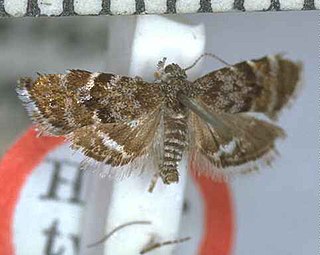
Asterivora marmarea is a species of moth in the family Choreutidae. It is endemic to New Zealand and lives in mountainous habitats. It has been observed in the lower parts of the North Island and the upper South Island. The larval host of this species is Celmisia gracilenta and adults of this species are on the wing in December and January.
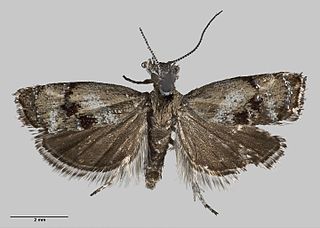
Asterivora urbana is a species of moth in the family Choreutidae. It is endemic to New Zealand and has been observed in Arthur's Pass. Adults are on the wing in January.
Glyphipterix ortholeuca is a moth in the family Glyphipterigidae. It is known from South Africa.
Brenthia pleiadopa is a species of moth of the family Choreutidae first described by Edward Meyrick in 1921. It is found in Magude, Mozambique.

Elachista cinereopunctella is a moth of the family Elachistidae found in Europe.
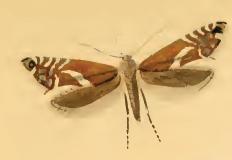
Glyphipterix haworthana, Haworth's glyphipterid moth, is a moth of the family Glyphipterigidae. It is found in most of Europe, as well as North America.

Glyphipterix equitella is a moth of the family Glyphipterigidae. It is found from Fennoscandia to the Iberian Peninsula, Sardinia, Sicily and Crete and from Ireland to Romania.

Crambus hamella is a species of moth in the family Crambidae described by Carl Peter Thunberg in 1788. It is found in most of Europe, east to the Russian Far East and Japan. It is also found in North America, including Alberta, Arizona, Manitoba, Michigan, Oklahoma and Ontario.

Glyphipterix acronoma is a species of sedge moth in the genus Glyphipterix. It is endemic to New Zealand and is found in the North and South Islands. It's preferred habitat is open fields on mountain sides and adults are on the wing in December and January.
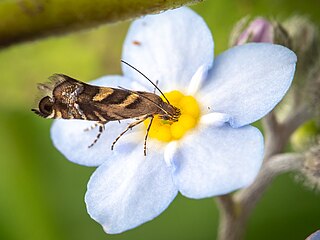
Glyphipterix tungella is a species of sedge moth in the genus Glyphipterix. It is endemic to New Zealand and is found throughout the country. Larvae mine the leaves of small sedges. Adults of this species are day flying and inhabit sheltered scrub or grassy areas and forest clearings.
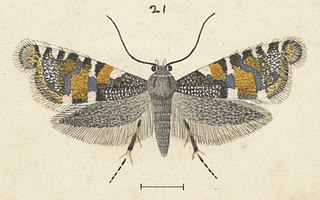
Glyphipterix euastera is a species of sedge moth in the genus Glyphipterix. It is endemic to New Zealand. This species is classified as "At Risk, Naturally Uncommon" by the Department of Conservation.
Glyphipterix gypsonota is a species of sedge moth in the genus Glyphipterix. It was described by Alfred Jefferis Turner in 1926. It is found in Australia, including Tasmania.
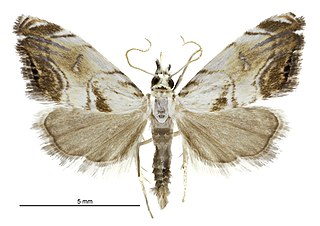
Glaucocharis harmonica is a moth in the family Crambidae. This species was described by Edward Meyrick in 1888. It is endemic to New Zealand and is found in the North and South Islands. It inhabits lowland to subalpine native forest. It has been hypothesised that there are two broods per year. The larval hosts are unknown. Adults are on the wing from October until January.
Nealyda pisoniae is a moth of the family Gelechiidae. It was described by August Busck in 1900. It is found in Cuba and the United States, where it has been recorded from Florida.
Polyhymno oxystola is a moth of the family Gelechiidae. It was described by Edward Meyrick in 1913. It is found in Mpumalanga, South Africa.















